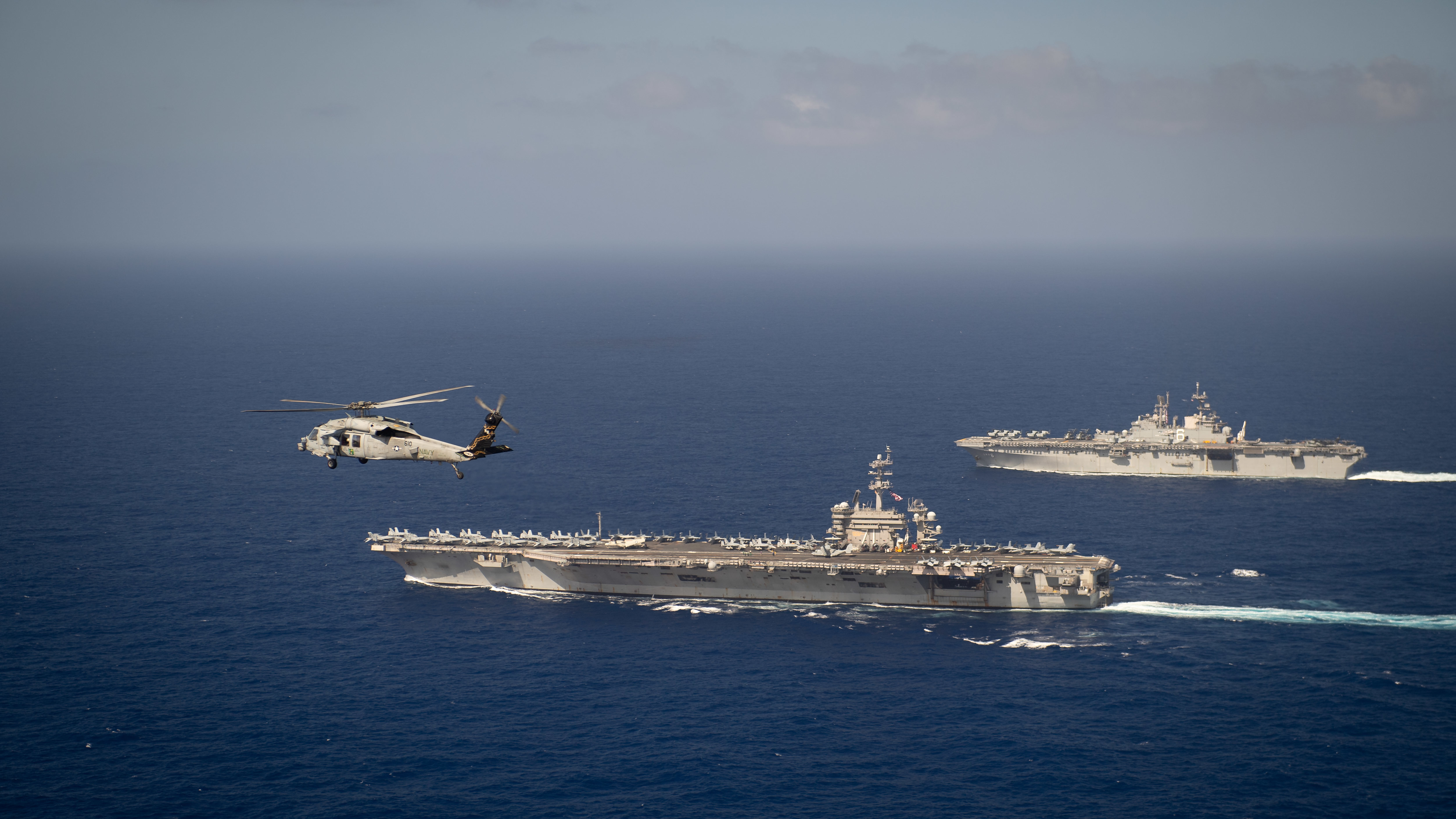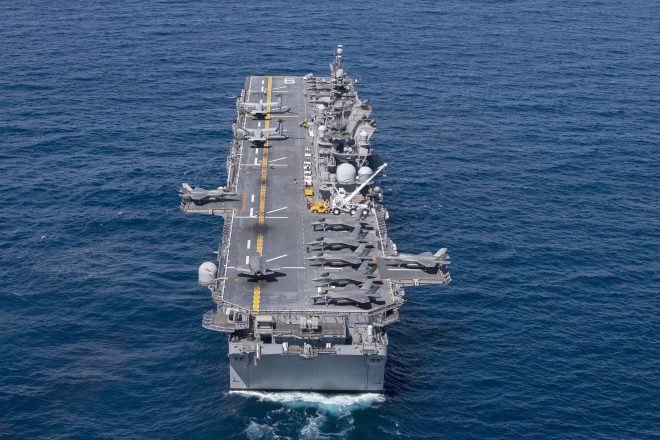
An MH-60S Sea Hawk, assigned to the “Eightballers” of Helicopter Sea Combat Squadron (HSC) 8, flies next to the aircraft carrier USS Theodore Roosevelt (CVN 71) and the amphibious assault ship USS America (LHA 6) while they transit the Pacific Ocean Feb. 15, 2020. Operating as an Expeditionary Strike Force, the Navy-Marine Corps team integrates carrier strike group combat power with the flexible capability of an expeditionary strike group to provide the fleet commander with a capable, credible combat force that can be deployed anywhere in the world. US Navy photo.
The Navy’s engineering community has already started conducting light carrier design and engineering studies, even as the Navy and the joint force still consider whether they’d even want to invest in a CVL to supplement supercarriers to bring more distributed capability to the fleet for less cost.
The idea of a light carrier resurfaced last summer as a Pentagon-led Future Naval Force Study was nearing its completion. The idea hadn’t appeared in Navy and Marine Corps plans, but then-Defense Secretary Mark Esper had a growing interest in the topic as he sought ways to keep future shipbuilding and sustainment costs down and as he worried about the Navy’s ability to conduct maintenance on its nuclear-powered aircraft carriers at Navy-run public shipyards.
The FNFS and the plan it produced, Battle Force 2045, ultimately recommended between zero and six light carriers and noted much more study would need to be done.
That work is already happening at Naval Sea Systems Command within the engineering and logistics directorate (SEA 05).
Rear Adm. Jason Lloyd, the SEA 05 commander and deputy commander for ship design, integration and engineering, said last week that his Cost Engineering and Industrial Analysis team has been studying different options to understand what operational utility the Navy would get out of each design and for what cost compared to the Ford-class carrier, “and then let the operators really, and the Navy, decide, hey, do we want that capability for that cost?”
“We have looked at an America-class possibility, we have looked at a Ford-class-light, we’ve looked at various different options and done cost studies on all those options. There are also capabilities studies on all those options,” Lloyd said last week while speaking at a virtual event hosted by the American Society of Naval Engineers.
“An aircraft carrier in World War II is not the same as a Nimitz-class carrier; there have been a lot of lessons learned over the years such as being able to do simultaneous launch and recovery, such as being able to safely maneuver aircraft once they’ve landed and still do simultaneous launch. So there’s a lot to an aircraft carrier flight deck that has been lessons learned over the years. So to go to a CVL light that we talked about has some tradeoffs. We say that it could be significantly less expensive, and it can be, it could be less expensive, but there are tradeoffs to that. So we have to go figure out what it’s going to be.”
Lloyd said the team started by dusting off previous carrier studies the Navy has done.

Thirteen U.S. Marine Corps F-35B Lightning II with Marine Fighter Attack Squadron (VMFA) 122, Marine Aircraft Group 13, 3rd Marine Aircraft Wing (MAW), and two Marine Medium Tilt-Rotor Squadron (VMM-166) are staged aboard amphibious assault ship USS America (LHA 6). America is at sea conducting routine operations in the eastern Pacific. US Navy photo.
“Just because a decision was made 10 years ago does not necessarily mean that decision is the right decision now. When you’re looking at littoral warfare or you’re looking at great power competition, those are two different adversaries, and the weapons that you need to fight those adversaries might be very different,” he said.
Lloyd also acknowledged that the makeup of the carrier air wing has a lot to do with what capability the Navy might want from a light carrier. In looking at previous carrier design studies, he said he realized just how much airplane technology had changed in recent years. For example, while the supercarrier may remain the preeminent design for launching manned aircraft, he said it’s not unreasonable today to think about a light carrier that would launch unmanned vertical-takeoff vehicles.
“I think it’s important to continue to think, hey, how does the change in the current warfare situation, as well as the capability of the weapon on the aircraft carrier, which is really the plane, how is that changing, and how do we capitalize on that?”
Carey Filling, the director of the Surface Ship Design and Systems Engineering directorate at SEA 05, said during the panel presentation that his office too has been heavily engaged with the carrier design work, along with their partners at Naval Surface Warfare Center Carderock, even though they typically focus more on surface ships than aircraft carriers.
“I will say that we certainly learned that it is hard to beat the sortie rate of the Ford. The Ford is optimized for its ability to deliver aircraft and ordnance off the ship at a high rate, so it’s hard to match that,” Filling said.
“I think the other thing to think about is the range of a nuclear carrier, its ability to move somewhere quickly and its speed, is hard to match.”
Filling and Lloyd were asked about the possibility of using the America-class design for the light carrier, and Lloyd said at this point they “don’t know” if that’s a road the Navy would go down.
Filling said LHDs and LHAs have a boxier design than aircraft carriers due to them having to also ballast down to launch and recover surface connectors in the water. That box shape keeps them from achieving the higher speeds that make a Ford- or Nimitz-class carrier more survivable, he said.
Still, Filling said, “I will say that our current LHD class for most nations is their primary carrier, and so our team has done a lot with the integration of the Joint Strike Fighter that make our current LHDs very capable. I think the limitations are acknowledged, though, that certainly vertical launch aircraft have limitations on range and payload, and that’s why this in-between study was asked for, to see if we could, for Distributed Maritime Operations, provide more carrier attack points than we have currently.”

Light Carrier Studies Already Underway As Navy Considers Role for CVLs in Future Fleet - USNI News
The Navy’s engineering community has already started conducting light carrier design and engineering studies, even as the Navy and the joint force still consider whether they’d even want to invest in a CVL to supplement supercarriers to bring more distributed capability to the fleet for less...


